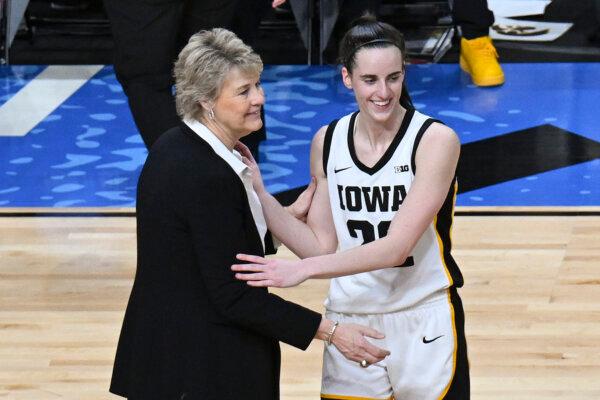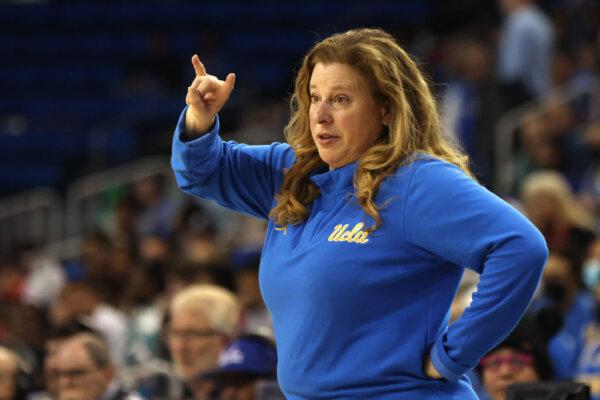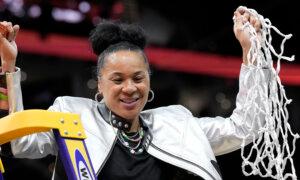Sunday’s NCAA women’s basketball championship game drew a bigger television audience than Monday’s men’s title game, a first-time occurrence, with an average of 18.9 million viewers watching undefeated South Carolina beat Iowa and superstar Caitlin Clark 87–75, according to ratings released Tuesday.
The Sunday afternoon women’s game on ABC and ESPN outdrew the Monday night men’s final between Connecticut and Purdue by four million. The Huskies’ 75–60 victory averaged 14.82 million on TBS and TNT.
The audience for the women’s game—in which the Gamecocks won their fourth national title and denied Clark’s Hawkeyes their first—peaked at 24.1 million during the final 15 minutes.
“You’re seeing the growth in many places: attendance records, viewership, and social-media engagement surrounding March Madness,” UCLA Coach Cori Close said. “I don’t think you can attribute it just to Iowa, though. A rising tide does lift all boats. But I think all those boats have been on many different waterways. The product is really good, and the increase of exposure is getting rewarded.”
It was the second most-watched non-Olympic women’s sporting event on U.S. television, trailing only the 2015 Women’s World Cup final between the United States and Japan, which averaged 25.4 million on Fox. That also was on a Sunday and took place in prime time on the East Coast.
The record for the most-watched women’s basketball game still belongs to the gold-medal game between the United States and Brazil in the 1996 Atlanta Olympics, which averaged 19.5 million. South Carolina Coach Dawn Staley played for that U.S. team.
Nielsen’s numbers include an estimate of the number of people who watched outside their homes, which wasn’t measured before 2020. Due to cord-cutting, the in-home audience has steadily declined annually.
The audience for the national-title game was up 90 percent over last year, when Clark and Iowa fell to Louisiana State. That also was the first time since 1995 that the championship was on network television.
The audience was 289 percent bigger than the viewership for the Gamecocks’ title two years ago, when they beat UConn on ESPN.
“I had not seen it [women’s basketball] much before this year,” said former CBS Sports President Neal Pilson, who now runs a sports television consulting company. “I didn’t make it appointment television. This year, it was appointment television. That’s what happened when you see those numbers. There were a lot of people making notes to sit down and watch the games.”
During the Final Four, Clark said the audience growth was benefiting all of women’s sports, not just basketball.
“I think you see it across the board, whether it’s softball, whether it’s gymnastics, volleyball,“ she said. ”People want to watch. It’s just when they’re given the opportunity, the research and the facts show that people love it.”
Clark and Iowa have the three biggest audiences for women’s college basketball. The Hawkeyes’ national-semifinal victory over UConn on Friday night averaged 14.2 million, and their April 1 victory over LSU in the Elite Eight drew 12.3 million.
Iowa’s six NCAA Tournament games on ESPN and ABC averaged 10.07 million.

As Clark heads to the WNBA, however, many wonder if the college game can continue to attract large audiences.
Clark was the marquee player of March Madness, but there was an impressive group of freshmen, headlined by Southern California’s JuJu Watkins, Notre Dame’s Hannah Hidalgo, and Madison Booker of Texas. Watkins set the NCAA record for points by a freshman with 920.
“There are also some great freshmen coming into the game next year who I think are going to make a tremendous impact,“ Ms. Close said. ”As long as we keep telling the story, there’s still room to grow the game.”
It also helped that the women’s game received increased national-television exposure during the regular season.
Fox carried 14 women’s games this season, including three in prime time. NBC aired two, and CBS had the Big Ten Tournament championship. ABC had five regular-season games and nine during the NCAA Tournament.
Fox has announced the Women’s Champions Classic for next season on Dec. 7. The prime-time doubleheader will feature UConn, Iowa, Louisville, and Tennessee.
Mr. Pilson said he thinks this year’s tournament has paved the way for further growth. Just maybe not at the level seen with Clark’s following.
“I wouldn’t call it a blip because I think the women’s game is going to definitely improve from ratings and exposure here on out,” he said. “The broadcast and top cable sports channels can still deliver an audience. Midseason coverage tends to focus on the teams and personalities to make the public aware of the athletes. But the game has improved over the last five years. It has become faster and more competitive. I also think they have learned from the NBA and NFL on how to promote stars.”
Most audiences during March Madness also tuned in before and after Iowa’s games.
UConn’s 80–73 win over Southern California in the Elite Eight on April 1, which tipped off after the Iowa game, averaged 6.7 million. During the Sweet 16 on March 30, LSU’s victory over UCLA, which preceded the Iowa game, averaged 3.8 million.
“The great thing about what’s happened the last two years is there are people who only watch out for Caitlin Clark, but there are also people who watch for Caitlin Clark and became interested in the other games,” said Jon Lewis, who runs the Sports Media Watch site. “It’s not like the Caitlin Clark games did amazingly well and every other game was at the same level that it was two years ago. They were also tuning in on days when Caitlin Clark didn’t play, which is really notable. Now, none of those numbers are at the level of what we saw for the Iowa games, but they are a lot better than what the tournament was getting before.”
The championship game’s return to network television has also benefited the women’s game. UConn’s victory over Tennessee in 1995 averaged 7.44 million on CBS. Despite ESPN’s work raising the profile of the tournament since it acquired the rights in 1996, the closest the network got to that number for the final was in 2002, when 5.68 million watched UConn beat Oklahoma.
“I think our game has been good for a long time and I think people have just missed the boat,“ Iowa Coach Lisa Bluder said during the Final Four. ”Now we’ve finally had the exposure, and people have understood, ‘Wow, I haven’t watched women’s basketball for a long time. I’ve missed something.’ I don’t think they’re going to want to miss anymore.
“Caitlin has certainly been a tremendous star for our game, but there are so many stars in our game. So, we’re just going to latch onto that next one next year.”







